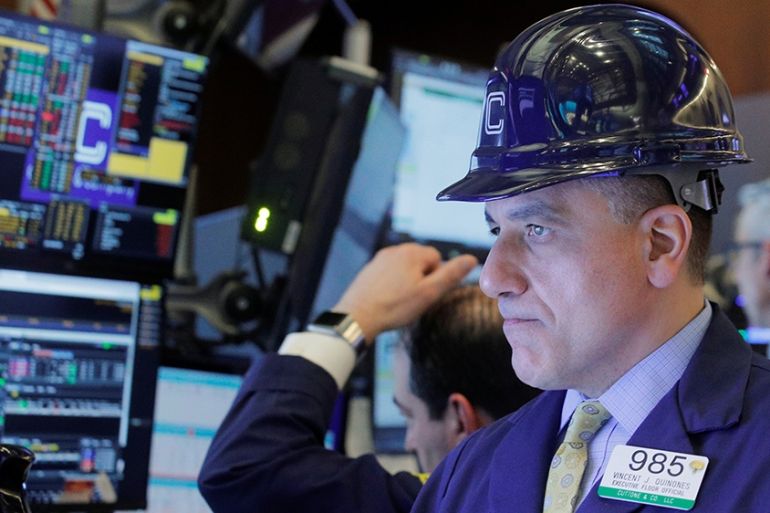Wall Street reckoning: Coronavirus drives worst week since 2008
Fears of a major hit to global growth from the outbreak have wiped a staggering $5 trillion off global stock markets.

Market pundits tend to embrace overblown words to describe big market moves to the downside: “bloodbath”, “pounding” and “nosedive”.
But all of those metaphors are fair game given the swiftness and severity of the sell-off that swept global stock markets this week, as the coronavirus outbreak continued to spread beyond China, heightening the risks of recession in the United States and globally.
Keep reading
list of 3 itemsOutbreak of fear: Dow plunges at open, extending brutal rout
Coronavirus outbreak ‘getting bigger’: All the latest updates
After falling more than 1,000 points on Friday, the Dow Jones Industrial Average pared its losses to finish down 357.28 points or 1.39 percent.
For the week, the Dow lost more than 3,500 points, or 12 percent – well into correction territory, which is defined by a drop of 10 percent or more.
The broader S&P 500 also finished in correction territory, rounding out Friday with a weekly loss of 11.5 percent.
Both indexes saw their biggest weekly percentage losses since the global financial crisis of 2008.
The Nasdaq Composite Index managed to eke out a positive finish on Friday, with 0.89 point gain or 0.01 percent.
More than five trillion dollars in market capitalisation was lost globally this week – roughly equivalent to Japan’s yearly economic output as measured by gross domestic product.
Some relief was in the offing on Friday after US Federal Reserve Chairman Jerome Powell released a statement at 2:30pm Eastern time (19:30 GMT) saying the US central bank is closely monitoring the evolving risks from coronavirus and will “act as appropriate to support the economy”.
But not even the power of the Fed could fully contain investor fears about the mounting risks coronavirus presents to global growth.
Wall Street’s so-called “fear gauge”, the CBOE Volatility Index, hit a high not seen for two years.
Even longtime market watchers were left slack-jawed by the speed with which investors bailed out of equities, as hopes faded that the coronavirus outbreak would be quickly contained.
The S&P 500 – seen as a proxy for US retirement savings accounts – lurched from a record high on February 19 to a correction a mere six days later.
As investors fled stocks, they sought shelter in safe havens like bonds, sending the yields on US treasuries to record lows on Friday. For bonds, prices and yields move in opposite directions.
A warning sign of recession from the US treasury market – the so-called “inverted yield curve” – steepened even further.
But not all traditional safe havens were entirely safe from the global market rout.
Gold, which is historically seen as the safest of bets in troubled and uncertain times, was sent on a roller coaster on Friday. Spot prices touched an intraday low not seen since 2013, before clawing back most of the loss.
Recession fears mounting
In China, where the coronavirus outbreak started last year, new infections are falling. But cases are rising in other parts of Asia, Europe and the Middle East.
On Friday, the first case of coronavirus was reported in sub-Saharan Africa after Nigerian health officials confirmed a case of COVID-19 in Lagos.
Nearly 50 countries have now confirmed cases of the virus.
On Friday, the World Health Organization raised its assessment of the global risk to “very high” from “high” – a move that the head of emergencies, Mike Ryan, said was intended to put national authorities on full alert.
“I think this is a reality check for every government on the planet – wake up, get ready, this virus may be on its way and you need to be ready,” Ryan said.
The global economy – already under pressure from the US-China trade war – has a whole new set of clouds gathering over it as the outbreak disrupts supply chains and international travel, causing major events to be cancelled.
Moody’s Analytics on Thursday said a “pandemic” would trigger global and US recessions in the first half of the year and boosted the odds of that scenario happening to 40 percent from 20 percent.
On Thursday, equity strategists at Goldman Sachs slashed their outlook for profit growth at US companies to zero.
Bank of America also revised its world growth forecast to the lowest level since the peak of the global financial crisis.
The latest WHO figures indicate that more than 82,000 people have been infected, with more than 2,700 deaths in China and 57 deaths in 46 other countries.